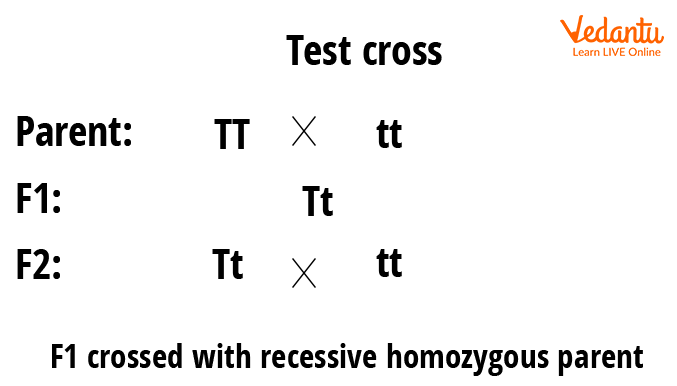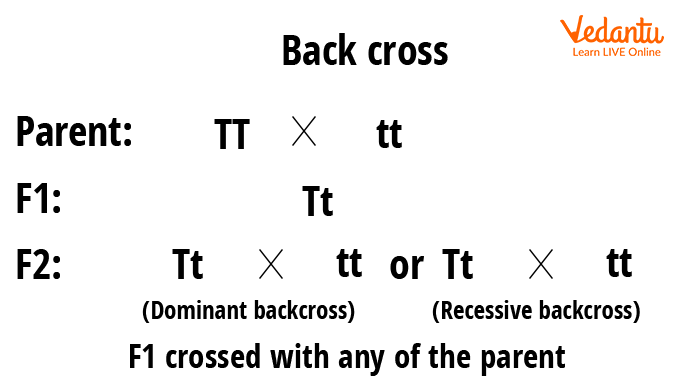How does a test cross help reveal unknown genotypes?
A test cross is a fundamental technique in genetics, used to determine the genotype of an organism showing a dominant trait. By crossing an unknown individual with a homozygous recessive one, scientists and breeders can reveal hidden genetic information. Understanding test cross helps students, breeders, and researchers predict inheritance patterns and improve trait selection in agriculture, medicine, and research.
What is a Test Cross?
To define test cross, it is a genetic cross between an individual with an unknown genotype and an individual that is homozygous recessive for a specific trait. This technique was introduced by Gregor Mendel to uncover whether the unknown individual is homozygous dominant or heterozygous. Test cross is essential in genetics, especially in Class 12 studies, to predict the possible genotypic ratios of the offspring.
Purpose and Significance of Test Cross
The significance of test cross lies in its ability to accurately determine the genotype of an organism displaying a dominant phenotype. Since both homozygous dominant and heterozygous individuals show the same outward appearance, test cross reveals the true genetic makeup by analyzing offspring outcomes. This method supports fields like agriculture, medicine, and biology, providing a precise approach to identifying inherited and acquired traits. For further reading, check difference between acquired and inherited traits.
Process: How to Perform a Test Cross
- Identify the organism showing the dominant trait (unknown genotype).
- Cross it with an organism that is homozygous recessive for the same trait.
- Collect and analyze the phenotype of the offspring from the cross.
- Interpret results:
- If all offspring show the dominant phenotype, the parent was homozygous dominant.
- If offspring display a 1:1 ratio of dominant to recessive phenotypes, the parent was heterozygous.
This simple yet powerful genetic cross is a standard practice for understanding Mendelian inheritance, including both monohybrid and dihybrid crosses. When dealing with dihybrid test crosses, researchers look at two traits at once to study independent assortment.
Test Cross Example
Let’s take a real-life test cross example often explained in Class 12. Imagine you are given a tall pea plant, but you do not know whether it is homozygous (TT) or heterozygous (Tt) for height. By crossing it with a dwarf plant (tt) you can analyze the offspring:
- If all offspring are tall (Tt), the unknown was TT.
- If half are tall and half are dwarf (Tt and tt in a 1:1 ratio), the unknown was Tt.
This outcome helps breeders select true-breeding plants or animals. See our pea plant page for more genetic applications.

Test Cross Ratio Explained
When conducting a test cross, the phenotypic ratio depends on the type of cross:
- Monohybrid test cross: 1:1 ratio if the unknown is heterozygous; all dominant if homozygous.
- Dihybrid test cross: Produces a 1:1:1:1 ratio if both genes are heterozygous, helping test the law of independent assortment. For a detailed explanation, visit dihybrid cross on Vedantu.
Knowing the test cross ratio is crucial for solving Mendelian genetics problems in board exams and competitive exams.
Test Cross and Back Cross: What’s the Difference?
| Feature | Test Cross | Back Cross |
|---|---|---|
| Definition | Cross between an unknown genotype and a homozygous recessive individual | Cross between offspring (F1) and either parent genotype |
| Main Purpose | Determine the genotype of the dominant-phenotype parent | Introduce or recover parental traits in the offspring |
| Offspring Types | Either all dominant or 1:1 dominant:recessive | Diverse, depending on which parent is used |
A test cross and back cross differ mainly in purpose and interpretation. While all test crosses are back crosses, not all back crosses are test crosses. Understanding this difference is vital for genetic breeding programs and plant improvement strategies.

Test Cross vs. Monohybrid and Dihybrid Crosses
In genetics, monohybrid test crosses examine one trait, whereas dihybrid test crosses study two traits. The dihybrid test cross ratio (1:1:1:1) is a clear result when both genes are unlinked and inherited independently. These crosses provide strong evidence for Mendel’s laws of inheritance, such as dominance, segregation, and independent assortment. Explore more about monohybrid cross for simpler patterns.
Applications of Test Cross in Biology
Test cross has practical value in multiple fields:
- Plant breeding: Ensuring new crop varieties are true-breeding for desired traits.
- Animal husbandry: Selecting animals with pure traits for reproduction.
- Genetic research: Verifying Mendelian ratios and laws.
- Medicine: Clarifying inheritance of certain diseases or conditions.
For more daily-life examples in science, see biological science.
Key Terms: Homozygous and Heterozygous
It is important to define the terms homozygous (identical alleles, e.g., TT or tt) and heterozygous (different alleles, e.g., Tt) when understanding the test cross. Only a homozygous recessive parent ensures that any recessive alleles in the unknown genotype become apparent in the offspring. For a deeper dive into genotype and phenotype, visit Difference Between Genotype and Phenotype.
Why Use Test Cross in Modern Biology?
Test cross is vital in today’s biology because it:
- Uncovers hidden genetic traits for better crop and animal selection.
- Supports studies on genetic disorders through clear genotype identification.
- Helps students understand genetics, preparing them for advanced courses and exams like NEET or JEE.
- Aids researchers in exploring new techniques for gene identification and inheritance patterns.
Its application extends into environmental science, epidemiology, and biotechnology. Check more on effects of climate changes and genetic adaptation.
Conclusion: The Value of Test Cross in Genetics
In summary, the test cross is an essential tool for uncovering the hidden genetic structure behind dominant phenotypes. Whether used in monohybrid or dihybrid cases, it plays a crucial role in genetics education, breeding, and scientific research. By mastering the test cross and back cross concepts, learners gain an edge in understanding biology’s core principles and applications.
To succeed in genetics, grasping the test cross—its process, interpretation, and application—is crucial. This technique empowers you to predict genetic outcomes, make informed decisions in breeding, and understand inheritance in real-world scenarios. For more on Mendelian inheritance and genetic concepts, Vedantu provides clear, accessible resources for all biology learners.


FAQs on Understanding Test Cross in Genetics
1. What is a test cross in genetics?
A test cross is a genetic cross used to determine the genotype of an individual showing a dominant trait. It is performed by crossing the individual in question with a homozygous recessive organism.
Key Points:
- Identifies if the dominant phenotype is homozygous dominant (pure) or heterozygous (hybrid).
- Used in Mendelian genetics and applied in plant and animal breeding.
- Helps analyze genotype using phenotypic ratios of offspring.
2. How is a test cross different from a back cross?
A test cross is always with a homozygous recessive parent, while a back cross involves crossing an F1 hybrid with either parent.
Main differences:
- Test cross: F1 hybrid × homozygous recessive
- Back cross: F1 hybrid × either parent (may be dominant or recessive)
- Test cross is specifically to determine unknown genotype
- Back cross can be for breeding or trait recovery
3. What is the significance of a test cross in Mendelian genetics?
A test cross is significant in Mendelian genetics for revealing unknown genotypes.
- It confirms homozygosity or heterozygosity of dominant phenotype individuals.
- Helps in studying Mendel's laws of inheritance and predicting offspring ratios.
- Useful for crop and animal breeding programs in agriculture and genetics research.
4. How do you perform a test cross? Describe the procedure.
To perform a test cross, cross an individual with an unknown dominant genotype to one known to be homozygous recessive for the trait in question.
Steps:
- Identify the individual with the dominant phenotype.
- Cross it with a homozygous recessive partner (i.e., genotype aa).
- Observe the phenotypes of the offspring.
- If all offspring show the dominant trait, the test individual is homozygous dominant; if a 1:1 ratio appears, it is heterozygous.
5. What is the expected phenotypic ratio in the offspring of a test cross?
The expected phenotypic ratio in a test cross depends on the genotype of the tested parent.
- If the parent is homozygous dominant: 100% dominant phenotype in offspring.
- If the parent is heterozygous: 1 dominant : 1 recessive (50% : 50%) ratio in offspring.
6. Why is a homozygous recessive individual always used in a test cross?
A homozygous recessive is always used in a test cross because it reveals the genotype of the other parent without masking recessive alleles.
- Ensures that any dominant allele in the other parent will be observable in offspring.
- Guarantees accurate detection of heterozygotes and homozygotes.
7. Can you give an example of a test cross in pea plants as per Mendel's experiments?
Yes, Mendel used test crosses to confirm plant genotypes. For example:
- Dominant pea plant with round seeds (genotype unknown) was crossed with a homozygous recessive plant (wrinkled seeds, rr).
- If all offspring had round seeds, parent was RR.
- If some offspring had wrinkled seeds (1:1 ratio), parent was Rr.
8. What information can a test cross provide to breeders or researchers?
A test cross allows breeders and researchers to identify an organism's genotype and make informed breeding decisions.
- Detects heterozygotes vs. homozygotes
- Predicts genetic makeup of future generations
- Helps maintain or improve genetic lines in agriculture and animal breeding
9. How does a test cross help in determining whether a trait is pure or hybrid?
A test cross helps reveal if a trait is pure (homozygous) or hybrid (heterozygous).
- All dominant offspring: parent is pure
- Half dominant, half recessive: parent is hybrid
- Easy and direct method as per genetic principles
10. In which situations is a test cross necessary in genetics?
A test cross is necessary whenever the genotype for a dominant trait is unknown and must be confirmed.
- Checking for genetic purity during breeding
- Genetic research and experimentation
- Determining correct parental combinations in plant/animal husbandry










